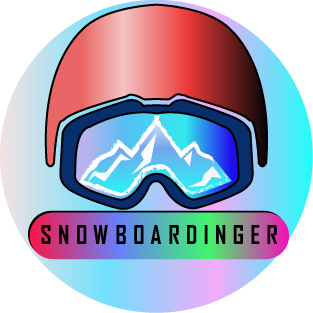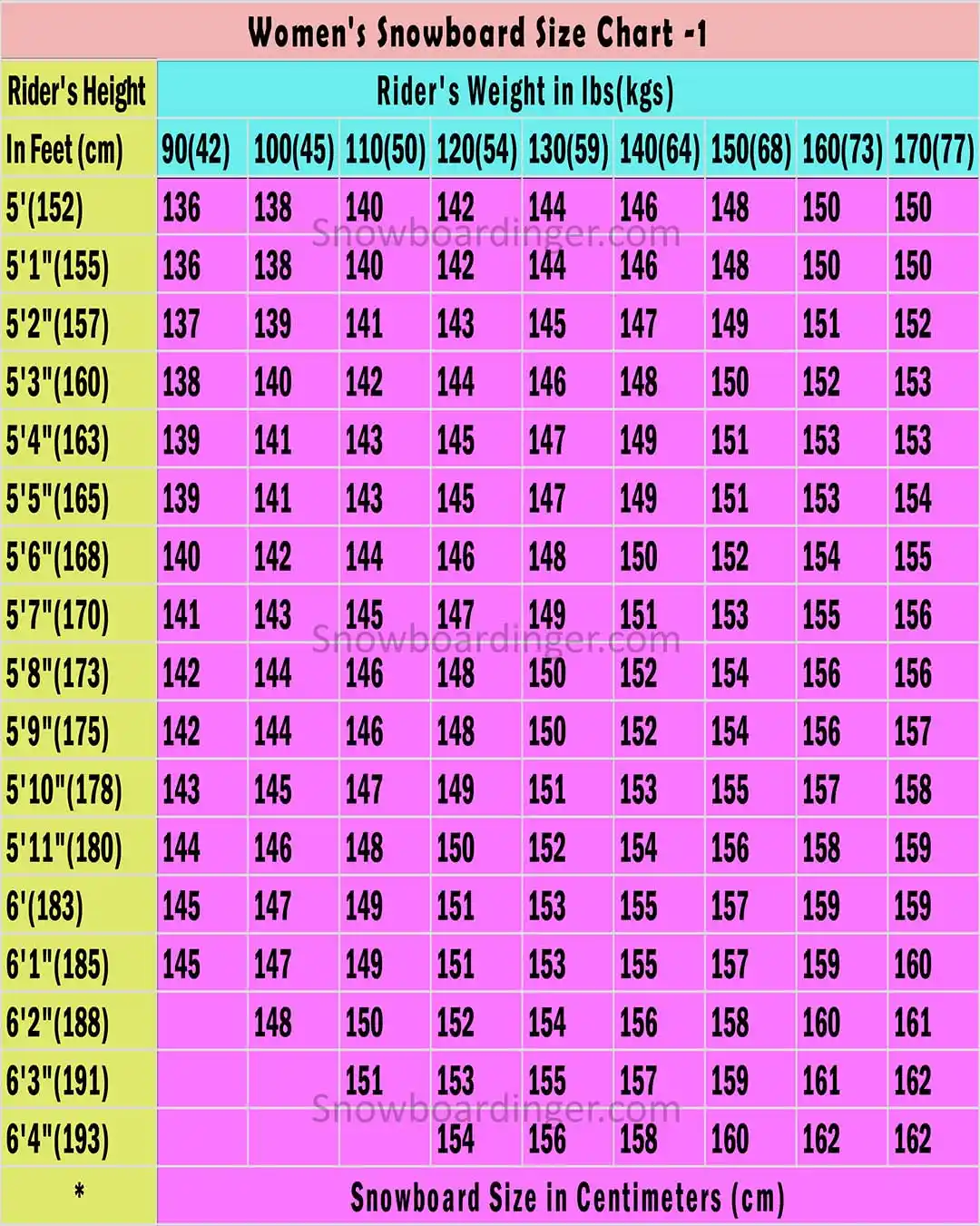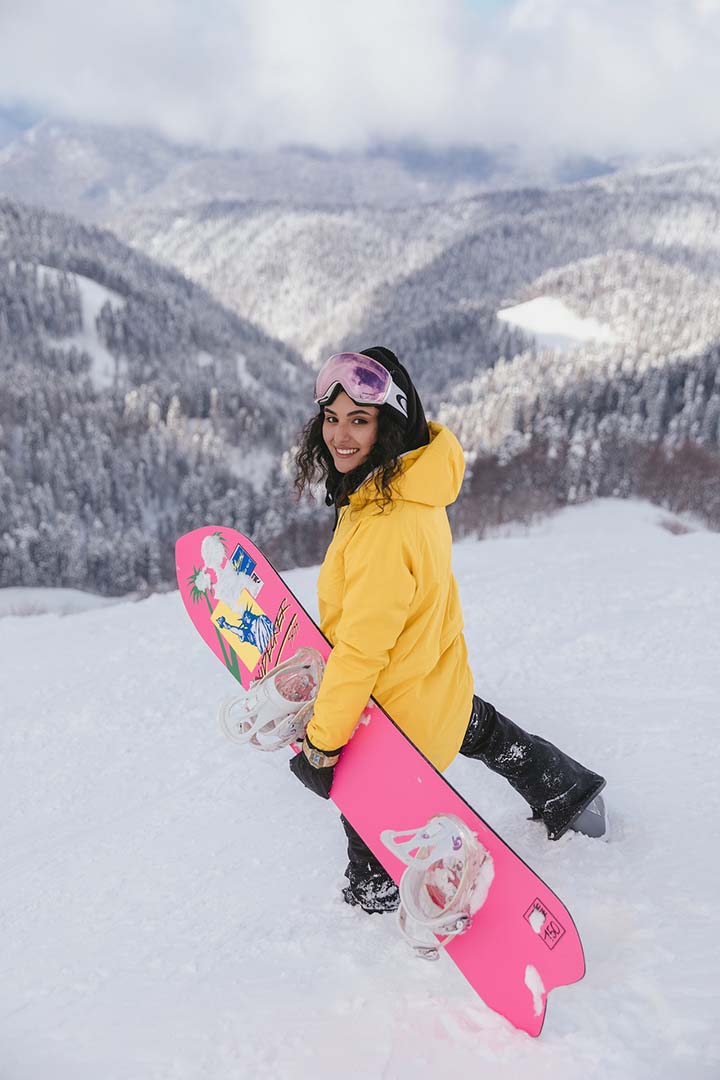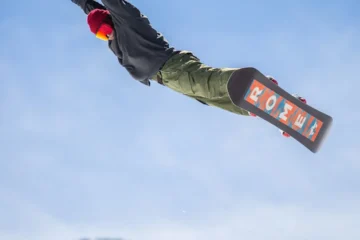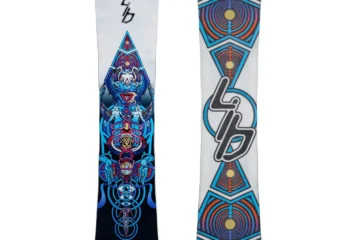A snowboard size chart is a useful tool for finding the right snowboard size for your height, weight, and riding style. This chart typically includes a range of snowboard lengths and widths that are recommended for different rider profiles. By using a snowboard size chart, you can ensure that your snowboard is the right size for you, which can improve your performance and overall experience on the mountain.
Snowboarding is a thrilling and exciting winter sport that has gained widespread popularity over the years. To fully enjoy this sport and maximize your performance, Having the right snowboard size can enhance your comfort, control, and stability on the slopes.
However, choosing the right snowboard size can be a confusing and challenging task, especially for beginners. That’s why a snowboard size chart is a useful tool that can help you determine the right size of a snowboard that suits your body type, skill level, and riding style. This post will provide an in-depth explanation of the factors that affect snowboard size and how to measure yourself for a snowboard. Additionally, we will look at the snowboard size chart in detail, and offer recommendations and tips for finding the perfect snowboard size for you.
Table of Contents
Below image shows how to use a snowboard size chart. First, you have to select your height and then your weight and the cross-section of both will give you an estimate of the right size of your snowboard.

Kids Snowboard size chart:
The snowboard size chart mentioned below is to give you the starting point and is just an estimate for the right snowboard size. Please use this as a starting point in the process of selecting the right snowboard for you.
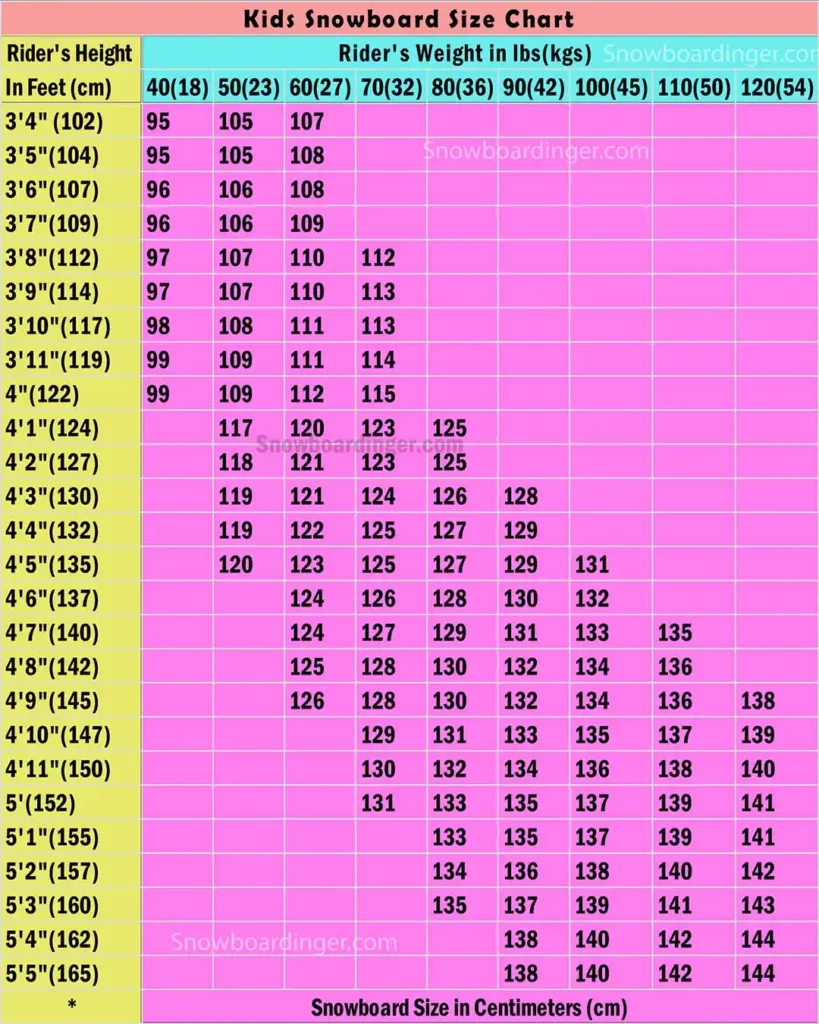
Men’s Snowboard Size Chart:
The snowboard size chart mentioned below is to give you the starting point and is just an estimate for the right snowboard size. Please use this as a starting point in the process of selecting the right snowboard for you.
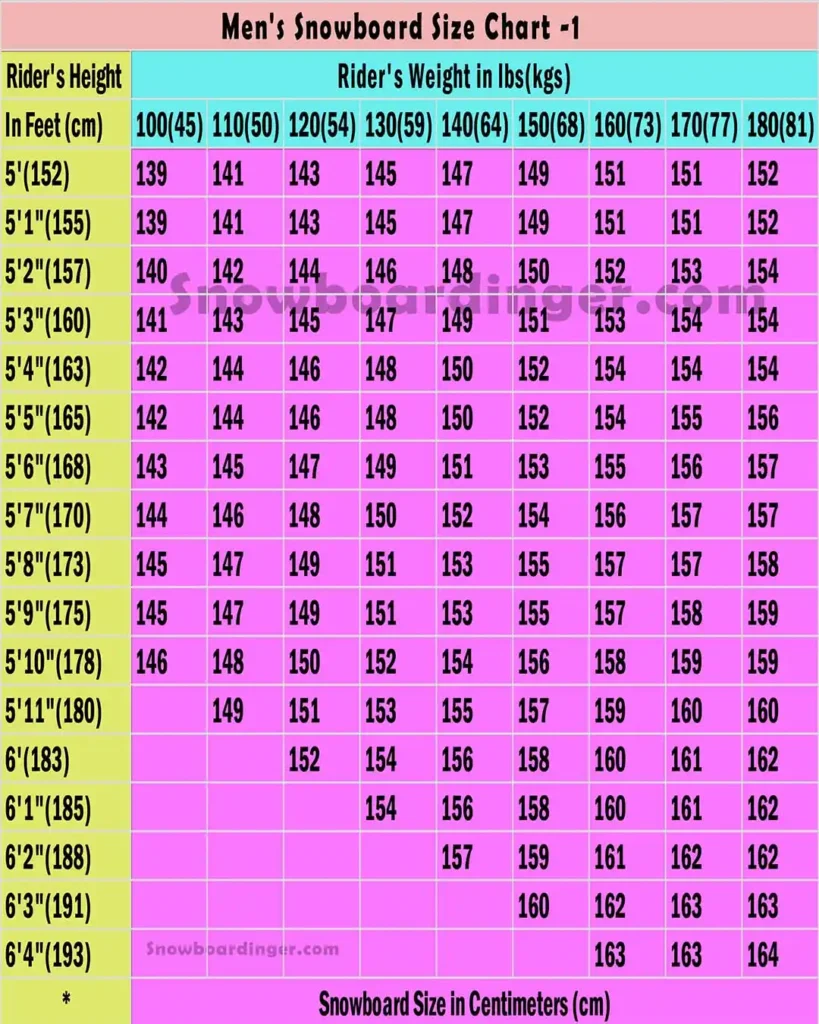
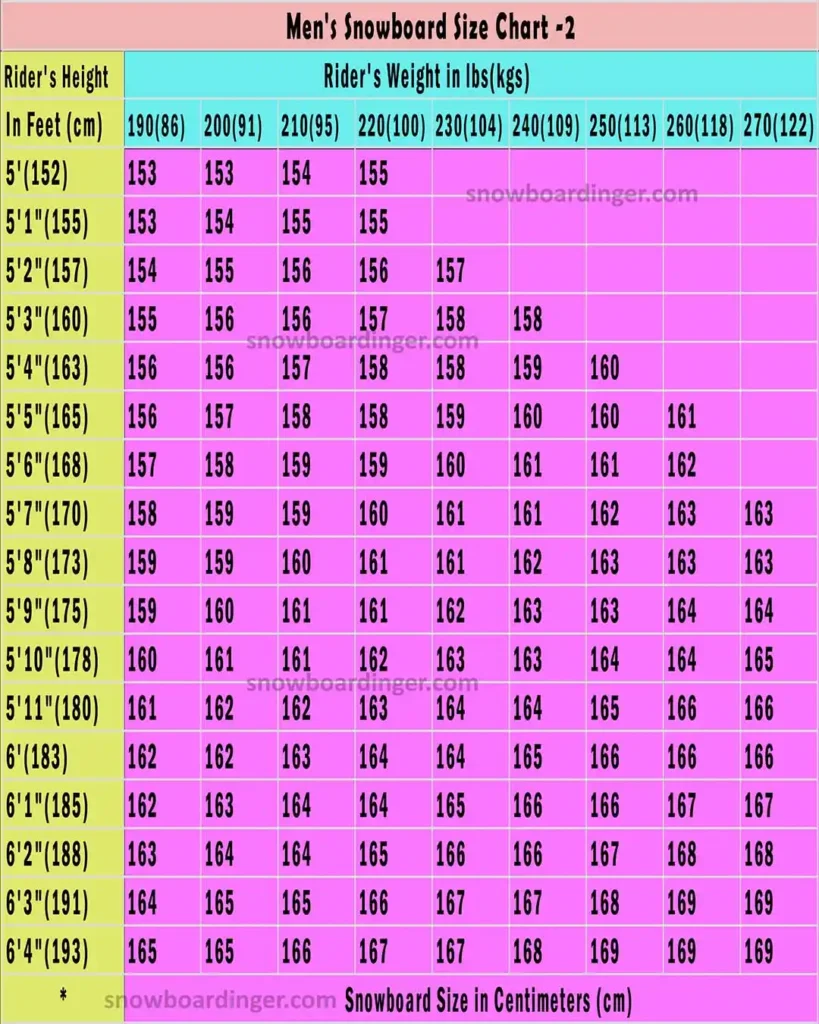
Women’s Snowboard size chart:
The snowboard size chart mentioned below is to give you the starting point and is just an estimate for the right snowboard size. Please use this as a starting point in the process of selecting the right snowboard for you.
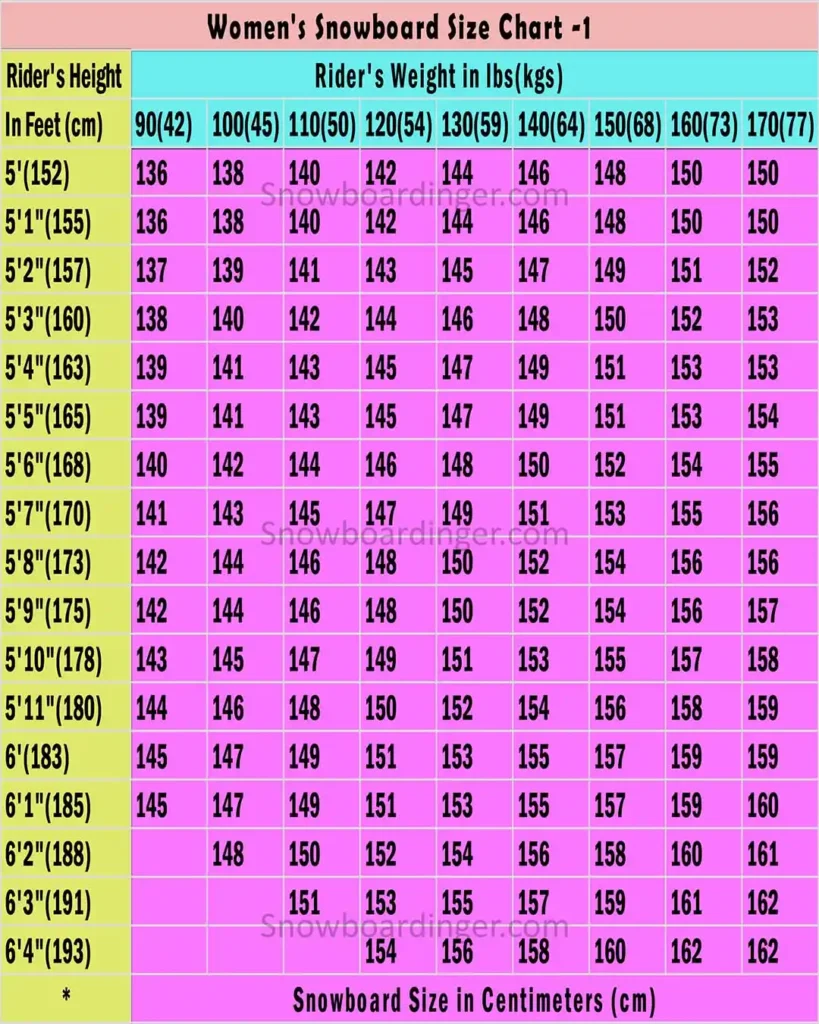
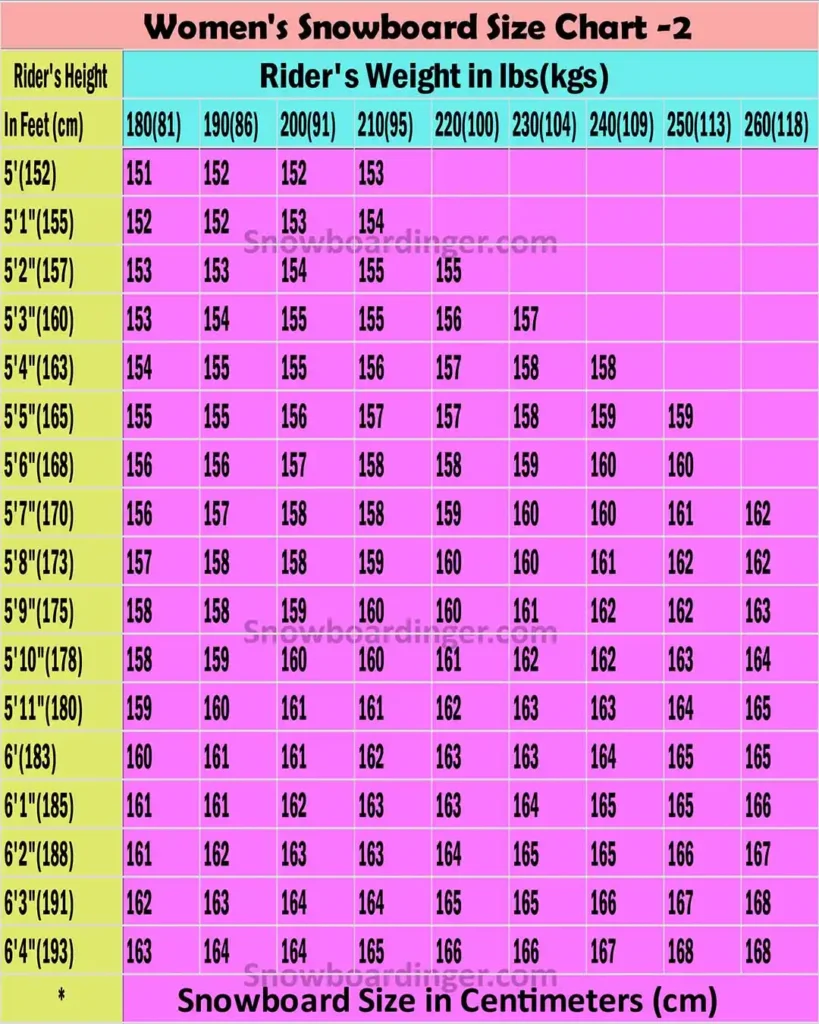
Please read our post about list of 5 best snowboard available on amazon, by clicking here
Factors Affecting Snowboard Size:
To determine the proper snowboard size, you need to consider several factors that affect how a snowboard will perform for you. Here are the key factors that you should keep in mind when choosing a snowboard size:
Rider’s Height:
One of the most obvious factors that influence snowboard size is the rider’s height. However, height is not the only determining factor, as the rider’s weight, skill level, and riding style also play a crucial role. The general rule of thumb is that a snowboard should reach between the rider’s chin and nose when standing upright on the board.
Rider’s Weight:
Your weight also plays an important role in determining the size of your snowboard. A heavier rider will require a larger snowboard to maintain balance and control, while a lighter rider may prefer a smaller board. The weight of the rider affects the snowboard’s flex, which is the amount it bends when riding. A snowboard that is too soft for a heavy rider can result in a lack of stability and control, while a board that is too stiff for a light rider can result in a lack of responsiveness.
Rider’s Skill Level:
The skill level of the rider is another important factor to consider when choosing a snowboard size. Beginners and intermediate riders typically require a shorter board, as it is easier to control and maneuver. An experienced rider may prefer a longer board for greater speed and stability. However, it is important to note that a longer board also requires more skill and strength to control.
Riding Style:
The riding style of the rider also plays a role in determining the proper snowboard size. Freeriders, who enjoy exploring the backcountry and off-piste terrain, typically prefer a longer board for increased stability and float in deep powder. Freestyle riders, who focus on tricks and stunts, may prefer a shorter board for greater control and maneuverability. All-mountain riders, who enjoy a mix of terrain, typically choose a board in the middle of the spectrum.
It is important to consider all these factors when choosing a snowboard size, as each one plays a crucial role in determining the overall performance of the board. A good way to get a feel for the right size is to try out different snowboards at a local ski shop or rental center, as this will give you an idea of how each board handles and performs for you.
So, we can say that choosing the right snowboard size is crucial for a safe and enjoyable snowboarding experience. By taking into consideration your height, weight, skill level, and riding style, you can find a snowboard that is the perfect fit for you. Additionally, trying out different boards and getting a feel for each one is highly recommended, as it will give you a better understanding of the right size for your needs. With the right snowboard size, you can take your snowboarding skills to the next level and enjoy the sport to the fullest.
How to Measure Yourself for a Snowboard:
Measuring yourself for a snowboard is an important step in choosing the right size. Here are the steps you should follow to measure yourself for a snowboard accurately:
Height Measurement:
To determine your height, stand upright against a wall with your shoes off. Measure the distance from the floor to the top of your head. This measurement will be used to determine the recommended length of the snowboard.
Weight Measurement:
Your weight is another important factor in determining the right snowboard size. You can use a bathroom scale to accurately measure your weight.
Foot Measurement:
Your foot measurement is also important when choosing a snowboard size, as it helps to determine the width of the board that will best fit your boots. To measure your foot, you can trace the outline of your foot on a piece of paper and then measure the length and width of the outline.
It is important to note that these measurements are just a starting point, and it is recommended to try out different snowboards to find the best fit for you. The weight, skill level, and riding style of the rider also play a crucial role in determining the proper snowboard size, so it is essential to take these factors into consideration as well.
In conclusion, measuring yourself for a snowboard is a simple and straightforward process that can help you determine the right size for your needs. By following the steps outlined above, you can get a good idea of the right snowboard size for your body type and riding style, ensuring a safe and enjoyable snowboarding experience.
Snowboard Size Chart and its Usage:
A snowboard size chart is a useful tool that provides recommended snowboard lengths based on a rider’s height, weight, skill level, and riding style. The chart is used to help riders determine the right size of snowboard for their needs, ensuring a safe and enjoyable snowboarding experience.
To use the size chart, riders need to know their height, weight, and foot measurement. The chart will then provide a range of recommended snowboard lengths, taking into account the rider’s weight, skill level, and riding style. For example, a rider who is 5’6″ tall, weighs 140 pounds, and has a foot measurement of 9″ will have a recommended snowboard length of 149 cm to 155 cm.
It is important to note that the size chart is just a starting point, and it is recommended to try out different snowboards to find the best fit for you. Every snowboard manufacturer may have a slightly different size chart, so it is essential to consult the size chart specific to the brand you are interested in.
In short, a snowboard size chart is a helpful tool for riders looking to determine the right size of snowboard for their needs. By using the chart and taking into consideration the rider’s height, weight, skill level, and riding style, riders can get a good idea of the right size, ensuring a safe and enjoyable snowboarding experience.
Recommended Snowboard Length Based on Riding Style:
Riding style is an important factor to consider when choosing the right snowboard length. Different riding styles require different lengths and widths of snowboards, so it is important to choose a board that is well-suited to your preferred style of riding.
Here are the recommended snowboard lengths based on common riding styles:
Freeride: Freeriders prefer to ride all-mountain terrain, including groomed runs, powder, and backcountry terrain. For this type of riding, a snowboard length of around 10 cm to 15 cm longer than your height is recommended.
Freestyle: Freestyle riders focus on riding park and pipe, performing tricks and stunts. For this type of riding, a snowboard length that is around 5 cm to 10 cm shorter than your height is recommended.
All-Mountain: All-mountain riders prefer to ride a mix of terrain, including groomed runs, powder, and backcountry terrain. For this type of riding, a snowboard length that is around 5 cm to 10 cm longer than your height is recommended.
Powder: Powder riders focus on riding in deep snow and powder, and require a snowboard that is long and wide. For this type of riding, a snowboard length that is 10 cm to 20 cm longer than your height is recommended.
It is important to note that these are general guidelines and that your weight, skill level, and foot measurement should also be taken into consideration when choosing a snowboard length. It is also recommended to try out different snowboards to find the best fit for you.
So, choosing the right snowboard length based on your riding style is an important factor in ensuring a safe and enjoyable snowboarding experience. By taking into consideration your preferred style of riding, you can choose a snowboard length that is well-suited to your needs, allowing you to make the most of your time on the mountain.
Choosing a snowboard size based on skill level, the following guidelines can be used:
Beginner:
For beginner riders, it’s important to start with a board that provides stability and makes it easier to balance. A board that is at least as tall as the rider or slightly taller is often recommended for beginners. This will allow for maximum stability and control, making it easier for them to learn how to snowboard. A longer board will also have a slower response time, which is beneficial for beginners who are still getting used to their equipment.
Beginners should look for a snowboard with a forgiving flex, which will make it easier to control the board and stay balanced. A board with a twin shape, or a directional twin shape, is often recommended for beginners, as it is versatile and easy to handle in a variety of conditions.
In general, a beginner snowboarder should aim for a board that is between their chin and nose in height, but it’s always best to consult with a professional or try out a few boards to determine the best size for you.
Intermediate:
As riders progress and become more confident in their abilities, they may want to consider a medium-length board. Intermediate riders typically prefer a board that is easier to maneuver and provides good control. A board that is between the rider’s chin and nose is often recommended for intermediate riders.
Intermediate riders may want to look for a board with a slightly stiffer flex, which will provide better control and stability at higher speeds. They may also want to consider a board with a directional shape, which is designed for all-mountain riding and provides good stability and control in a variety of conditions.
It’s important for intermediate riders to choose a board that is comfortable and easy to handle, but also provides the control and performance they need to continue to progress and develop their skills.
Advanced:
Advanced riders often choose a shorter board for greater control and agility. They typically prefer a board that is more responsive and allows for quick turns and tight carving. A board that is around the rider’s nose or even shorter may be recommended for advanced riders.
Advanced riders should look for a board with a stiff flex, which provides a more aggressive response and allows for precise control. They may also want to consider a board with a directional shape, which is designed for all-mountain riding and provides good stability and control in a variety of conditions.
It’s important for advanced riders to choose a board that is comfortable and easy to handle, but also provides the control and performance they need to continue to progress and develop their skills.
It’s important to keep in mind that these are general guidelines and that a rider’s height, weight, riding style, and terrain preferences should also be considered when choosing a snowboard size. It is also recommended to try out different snowboards to find the best fit for your abilities and preferences.
In conclusion, choosing the right size snowboard is important for a safe and enjoyable snowboarding experience, regardless of your skill level. Whether you’re a beginner, intermediate, or advanced rider, it’s important to consider your height, weight, riding style, and terrain preferences when choosing a snowboard. By following these guidelines and trying out different snowboards, you can find the best fit for your abilities and preferences and ensure that you have a fun and safe time on the mountain.
CONCLUSION:
The proper size of a snowboard is crucial for a safe and enjoyable snowboarding experience. A snowboard size chart can be a helpful tool in determining the recommended length of a snowboard based on a rider’s height, weight, skill level, and riding style. However, it is important to keep in mind that the chart is only a starting point and that other factors, such as weight and riding style, also play a role in determining the best size for a rider.
It is highly recommended to try out different snowboards to find the best fit for you, as this will help you ensure that you have chosen the right size and type of board for your needs. Trying out a snowboard before purchasing can also give you an opportunity to get a feel for the board and determine if it is comfortable and easy to maneuver.
In summary, the key points to consider when choosing a snowboard size are your height, weight, skill level, and riding style, and it is important to try out different snowboards to find the best fit for you. With the right size and type of snowboard, you can ensure a safe and enjoyable snowboarding experience.
FAQ about Snowboard Size Chart:
Frequently Asked Questions and Their Answers About Snowboard Size Chart:
What is a snowboard size chart?
A snowboard size chart is a tool that provides recommended snowboard lengths based on a rider’s height, weight, skill level, and riding style. It helps riders determine the right size of snowboard for their needs.
How do I use a snowboard size chart?
To use a snowboard size chart, you will need to know your height, weight, and foot measurement. The chart will then provide a range of recommended snowboard lengths, taking into account your weight, skill level, and riding style.
Is the size chart the only factor in choosing a snowboard?
The size chart is just a starting point, and it is important to take other factors into consideration when choosing a snowboard. Your weight, skill level, and riding style all play a crucial role in determining the proper snowboard size, and it is recommended to try out different snowboards to find the best fit for you.
Can I choose a snowboard size based only on my height?
Choosing a snowboard size based only on your height is not recommended. Your weight, skill level, and riding style also play a crucial role in determining the proper snowboard size.
What is the difference between a freeride snowboard and a freestyle snowboard?
A freeride snowboard is designed for all-mountain terrain, including groomed runs, powder, and backcountry terrain. A freestyle snowboard is designed for park and pipe riding, performing tricks and stunts.
How do I determine my skill level for a snowboard size chart?
Your skill level is typically categorized as beginner, intermediate, or advanced. Beginners typically have limited experience, intermediate riders have more experience, and advanced riders have extensive experience and skill.
Can I use a snowboard size chart for kids?
Yes, snowboard size charts are available for kids as well. It is important to choose a snowboard size that is appropriate for their height, weight, and skill level.
Is there a universal table available for a snowboard size chart?
I’m sorry, but it’s not possible to create a universal table for snowboard size based on height, weight, and skill level, as there are many variables that can affect the recommended size of a snowboard. For example, different manufacturers may have slightly different size charts, and the same rider may need a different size board based on the type of riding they will be doing. It’s recommended to use a snowboard size chart as a starting point, but to also take into consideration your weight, skill level, and riding style, and to try out different snowboards to find the best fit for you.
